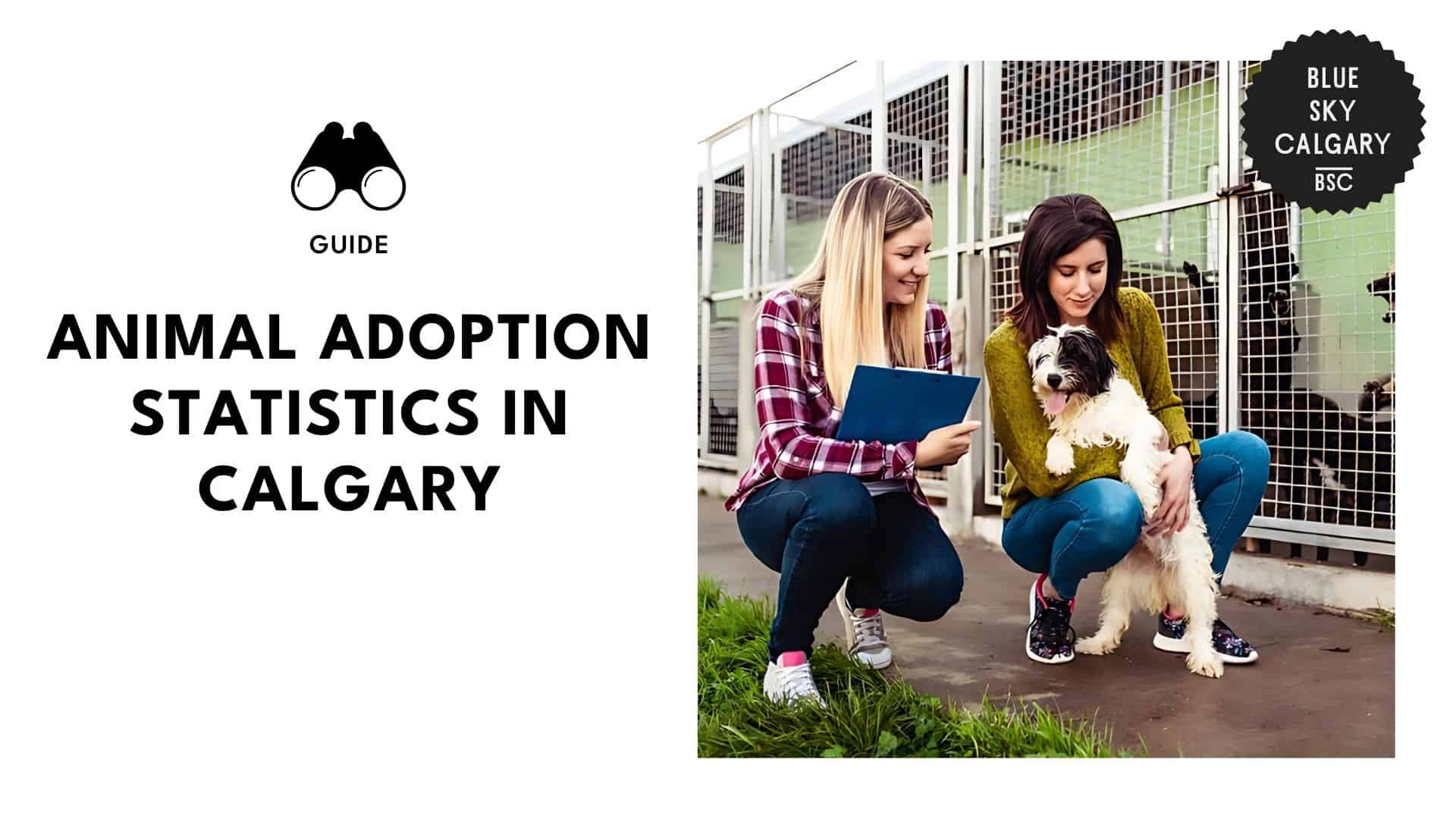Animal Adoption in Calgary: Statistics, Insights, and Projections
Key Insights
| According to the Calgary Humane Society’s annual report in 2024, a total of 3,614 animals were taken in by the organization, while 2,607 were adopted by residents in the city. When compared to other cities that also operated Humane Societies in Canada in 2024, Calgary ranked third for the total number of animals adopted. The Calgary Humane Society shows that between 2022 and 2023, the total number of foster homes dropped from 1,715 to 1,696. Animal placements also decreased from 1,159 to 542. Data from the Angus Reid Institute shows that during the COVID-19 pandemic, 28% of Canadian pet owners reported adopting or purchasing a pet. Most of these adopters were aged 18 to 34, at 32% of the adopting population. The City of Calgary offers standard adoption rates for all its available pets, at $169 plus GST for cats and $225 plus GST for dogs. These fees already cover various medical services, microchipping, and city licensing. |
The Calgary Humane Society took in a total of 3,614 animals in 2024, which shows that there was a fairly high number of animals in the city that needed some form of aid.
Each admission to the organization represents a case where intervention was necessary, whether due to surrender, abandonment, or other circumstances requiring immediate care.
Managing this volume of animals places a significant demand on space, staffing, and medical resources throughout the year.
Thus, adoption programs are a vital part of the organization’s daily operations, as these allow them to better manage their resources and intake a higher number of animals in need.
A total of 2,607 animals were adopted by residents in the city within the same period. Based on the year’s intake, this means roughly 72% of all animals that entered the shelter were successfully placed into new homes.
While the adoption rate is relatively strong, there were still more than 1,000 animals that remained in care, were transferred to other shelters, or had unresolved outcomes by the end of the year.
Cats were the most frequently admitted species, with 2,110 intakes. Of this number, a total of 1,621 cats found adoptive homes, resulting in an adoption rate of around 77%.
The relatively high success rate for cat adoptions may be linked to stronger community interest, easier space requirements for cat housing, or fewer requirements needed for adoption.
Meanwhile, dogs made up 1,011 of the total intakes. With 613 dogs adopted during the year, the adoption rate for dogs stood at 61%, which is a bit lower than the rate for cats.
Several factors that may contribute to the difference include housing restrictions, behavioral challenges, and preferences for specific dog breeds. Larger dogs, in particular, often face more difficulty finding suitable adoptive homes.
Rabbits had a smaller intake overall. A total of 113 rabbits came into the shelter, and another 76 were adopted, which is an adoption rate of 67%.
Many rabbit owners may not be fully informed about the long-term care requirements for these pets, which can lead to higher surrender rates. However, the fairly high adoption numbers suggest that there is still a growing interest in these animals.
Other species, including birds, reptiles, and small mammals, made up another 380 of animal intakes. Of this total, 297 were adopted, leading to an adoption rate of 78%, which is the highest of all categories.
However, it is important to note that since this category groups together several species, this could lead to a higher adoption rate overall.
Animals in this group are often adopted through specialized rescues or foster networks, which may also allow for quicker placement and more targeted outreach.
The overall adoption rates for all animals suggest that while the majority of them do find homes, a significant number still face delays or barriers to successful placements.
| Species | Number of Animal Intakes | Number of Adoptions | Adoption Rate |
| Cats | 2,110 | 1,621 | 76.80% |
| Dogs | 1,011 | 613 | 60.60% |
| Rabbits | 113 | 76 | 67.30% |
| Other Animals | 380 | 297 | 78.2% |
| Total | 3,614 | 2,607 | 72.10% |
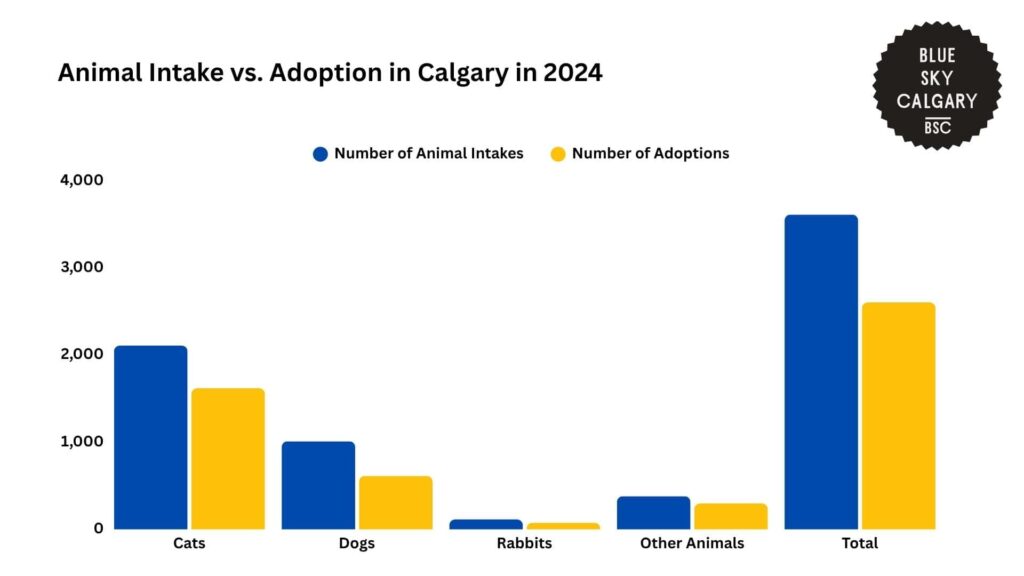
Regional Analysis of Adoption Rates Across Cities in Canada
Several cities in Canada operate Humane Societies that focus on animal rescue, rehabilitation, and adoption.
These organizations serve as regional hubs for pet care and shelter services, helping reduce the burden on municipal systems and preventing overcrowding.
While each city has unique programs and operational structures, their annual adoption totals reflect how effectively they place animals into new homes.
Winnipeg Humane Society reported the highest adoption total among the listed cities, with 4,170 animals placed in 2024. This number is 60% higher than Calgary’s total of 2,607.
Their higher volume may be supported by larger shelter networks, stronger foster programs, or greater public demand for adoption across surrounding cities in the region.
Edmonton followed with 3,905 adoptions, which is 50% more than Calgary’s figure. As Alberta’s largest city, Edmonton likely benefits from more expansive shelter infrastructure and higher intake capacity, allowing it to rehome more animals.
Calgary itself placed 2,607 animals in adoptive homes. This shows that despite the presence of other Humane Society organizations nearby, Calgary still successfully adopts out a significant number of animals when compared to other cities.
Meanwhile, Regina reported 2,077 adoptions. Compared to Calgary, Regina’s total is about 20% lower.
The small gap suggests relatively strong performance for a city with a lower population and possibly fewer shelter resources.
Toronto recorded 1,730 adoptions, which is 34% below Calgary’s number. Despite its size, Toronto’s lower total may point to a more fragmented shelter system or greater reliance on private rescues and adoption agencies.
Cochrane registered 1,112 adoptions, which is 43% of Calgary’s total. Although this is a smaller municipality, it also has a fairly high adoption rate.
Finally, Etobicoke had 279 adoptions in 2024. That figure is nearly 90% lower than Calgary’s total, which could be attributed to limited shelter capacity, smaller service areas, or fewer animal intakes compared to larger cities.
It is also important to note that these numbers reflect the adoption rates of Humane Society organizations in Canada and do not capture the full adoption rates per city.
Within each city, there may be other similar public and private organizations that offer animal adoptions, and whose numbers are not reflected in these totals.
| City | Number of Adoptions | % Compared to Calgary |
| Calgary | 2,607 | – |
| Cochrane | 1,112 | 43% |
| Winnipeg | 4,170 | 160% |
| Edmonton | 3,905 | 150% |
| Etobicoke | 279 | 11% |
| Regina | 2,077 | 80% |
| Toronto | 1,730 | 66% |

Animal Fostering Trends in Calgary
Data from the Calgary Humane Society from 2020 to 2023 shows that the city continues to rely heavily on its foster program to support animals in transition.
In 2020, a total of 478 foster homes were active in the city. This number reflected the beginning stage of the program, which was still growing and adapting to meet community needs during the early months of the pandemic.
By 2021, the number of foster homes had increased to 750. The 57% rise from the previous year shows stronger recruitment efforts and greater public awareness.
As more residents began opening their homes to animals in need, the Humane Society was able to extend its care capacity beyond the walls of its shelter.
The following year, in 2022, the number of foster homes rose sharply to 1,715. This marked a 129% increase from the previous year and was the highest figure recorded over the four-year period.
Dramatic growth during this year suggests a major shift in how animal care was being delivered in Calgary, with many more animals spending time in community settings rather than at the shelter.
In 2023, the number of foster homes remained high at 1,696. While slightly below the peak of the previous year, the count was still more than double the total from 2021.
However, the small decrease may also reflect changes in volunteer availability or adjustments in the foster program’s capacity.
Animal placements followed a different trend during the same time period.
In 2020, there were 750 recorded placements, aligning closely with the number of foster homes available that year and suggesting that most placements involved one animal per home or short-term care.
By 2021, placements increased to 1,163. The 55% rise suggests that the expanded foster network was successfully supporting more animals at once, either through faster turnover or larger volumes of animals per home.
The next year, in 2022, another 1,159 animals were placed. While this was a small decrease from the year before, the number still reflects a high level of foster activity.
However, in 2023, placements dropped significantly to 542. This represented a 53% decrease compared to 2022.
As this number reflects the total number of animals placed in new homes, the implications here could go both ways. Decreases in these numbers could either mean fewer homes available or a smaller number of animals needing aid.
According to the Humane Society, 11% of animals spent over 53% of their total time in foster homes, which suggests that families were keeping animals for longer durations.
Looking ahead, the Humane Society plans to expand the program further. Their goal is to provide every animal in care with access to a foster home.
| Year | Foster Homes | % Change from Previous Year | Animal Placements | % Change from Previous Year |
| 2020 | 478 | – | 750 | – |
| 2021 | 750 | +57% | 1,163 | +55% |
| 2022 | 1,715 | +129% | 1,159 | -0.3% |
| 2023 | 1,696 | -1% | 542 | -53% |
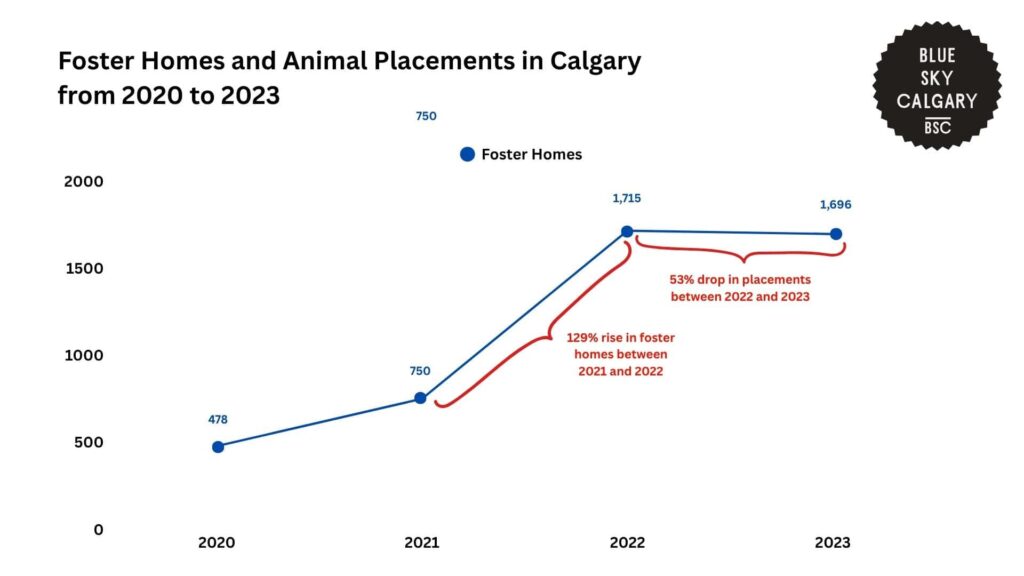
Animal Adoption Trends in Calgary During the COVID-19 Pandemic
The Angus Reid Institute shows how animal adoption trends in the country shifted during the COVID-19 pandemic.
Throughout the COVID-19 lockdowns, 28% of Canadian pet owners reported adopting or purchasing an animal, with the group reporting that they still have this pet.
This figure highlights a surge in pandemic-era pet ownership, with nearly 3 in 10 households taking in a new animal during this period.
Among male pet owners, 28% said they adopted or bought a pet during the lockdown and have kept it since.
The adoption rate for females was exactly the same, at 28% of the total population, showing that there was no significant difference between genders in pet adoption behavior during the pandemic.
Age played a more significant role in shaping adoption patterns. Among pet owners aged 18 to 34, 32% said they adopted or bought a pet during the pandemic lockdowns.
Notably, this was the highest share among all age groups, suggesting that younger adults were more likely to seek companionship during these extended periods of isolation at home.
Among those aged 35 to 54, 31% reported the same. Since this is only slightly lower than the youngest group, by just one percentage point, the number still reflects a strong adoption trend among middle-aged adults.
Within the oldest group, aged 55 and above, only 21% reported getting a pet during the lockdowns that they still currently have.
An 11 percentage point gap between the youngest and oldest age groups shows how much age influenced pet adoption during COVID-19.
When comparing the two youngest age groups combined (18–54) with the 55+ population, younger Canadians were nearly 50% more likely to adopt a pet during the lockdown.
| Group | Percentage that Adopted a Pet |
| All Pet Owners | 28% |
| Male Pet Owners | 28% |
| Female Pet Owners | 28% |
| Age 18–34 | 32% |
| Age 35–54 | 31% |
| Age 55+ | 21% |
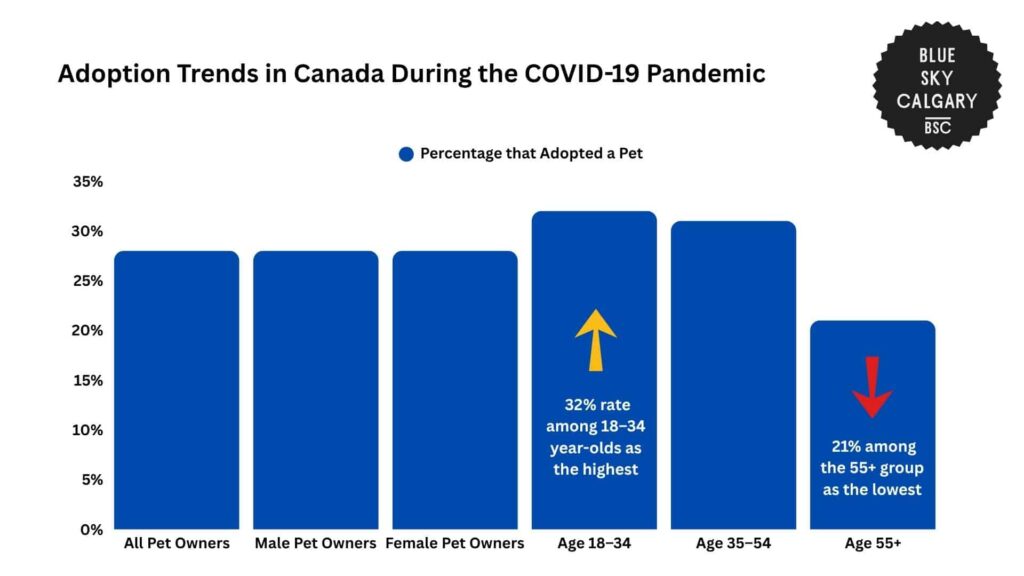
Costs of Pet Adoption and Ownership in Canada
In order to centralize pet adoptions, the City of Calgary sets standard adoption rates for its available animals.
The city’s adoption fees are $169 plus goods and services tax (GST) for cats, and $225 plus GST for dogs.
These fees already include spay or neuter services, vaccinations, microchipping, city licensing, dental care, and medical exams.
Alongside these initial adoption fees, the 2025 Cost of Pet Parenthood Report shows other costs that prospective adopters could expect.
Dog owners typically spend between $965 and $4,020 per year. Meanwhile, cat owners spend slightly less, with yearly costs ranging from $930 to $2,400.
Most of these expenses go toward food, treats, medical care, and basic supplies. For families already facing financial stress, these figures can discourage pet adoption or lead to difficulties in keeping a pet long-term.
However, lifetime costs reflect even higher expenses for pet owners. Over the course of ownership, cat parents may spend up to $73,585, while dog owners could face lifetime expenses of up to $53,935.
Included in these figures are regular vet checkups, emergency care, and end-of-life services. The high costs may deter some families from adopting, especially if they are not prepared for the ongoing financial responsibilities.
Food and treats represent the most consistent monthly expense. For dogs, 74% of owners report this as their highest recurring cost, while an even higher number of cat owners report the same at 81%.
It is also important to note that Alberta is among the most expensive provinces in Canada for pet care. Along with Ontario, Alberta reports higher-than-average veterinary fees and adoption-related costs.
In contrast, provinces like Quebec and British Columbia offer more affordable options. Families in Calgary may feel additional strain due to these regional price differences, which can influence how many pets a household can responsibly support.
Moreover, the financial strain of pet ownership is being felt across many Canadian households.
About 58% of pet owners report seeing higher prices for food, services, and products. Another 63% say they’ve made lifestyle adjustments because of these rising costs.
In practice, this can mean cutting back on groceries, transportation, or entertainment to afford pet care, which may discourage new adoptions.
Despite the challenges, the emotional value of pet ownership remains strong. Around 96% of pet parents in Canada consider their pets family members.
Even as costs rise, many are willing to make changes in order to keep their animals at home. For animal shelters in Calgary, this presents an opportunity to expand education on financial planning and pet budgeting to help prevent unnecessary surrenders.
Financial planning also plays a growing role in how families approach pet ownership. About 37% of owners set aside money for surprise expenses, while 36% use budgeting tools to manage monthly costs.
However, not all pet owners are financially prepared. About 15% of pet owners do not budget for future costs.
Among new pet parents, 25% of cat owners report failing to plan for the financial responsibilities of adoption. Without a clear understanding of the expenses involved, families may struggle to provide consistent care, which increases the risk of surrender.
Overall, prospective adopters in the city will need to consider a range of expenses during the adoption process, from initial city fees to the long-term costs of caring for their new pet.
| Category | Statistics |
| Adoption Costs | Dogs: $225 + GSTCats: $169 + GST |
| Yearly Cost Range for Pet Ownership | Dog Owners:$965 to $4,020 Cat Owners:$930 to $2,400 |
| Expected Annual Cost Increase | Dog Owners: Up to 18% Cat Owners: Up to 41% |
| Lifetime Cost | Dog Owners: Up to $53,935 Cat Owners: Up to $73,585 |
| Report Rising Pet Costs | 58% of pet parents |
| Adjusted Lifestyle Due to Pet Expenses | 63% of pet parents |
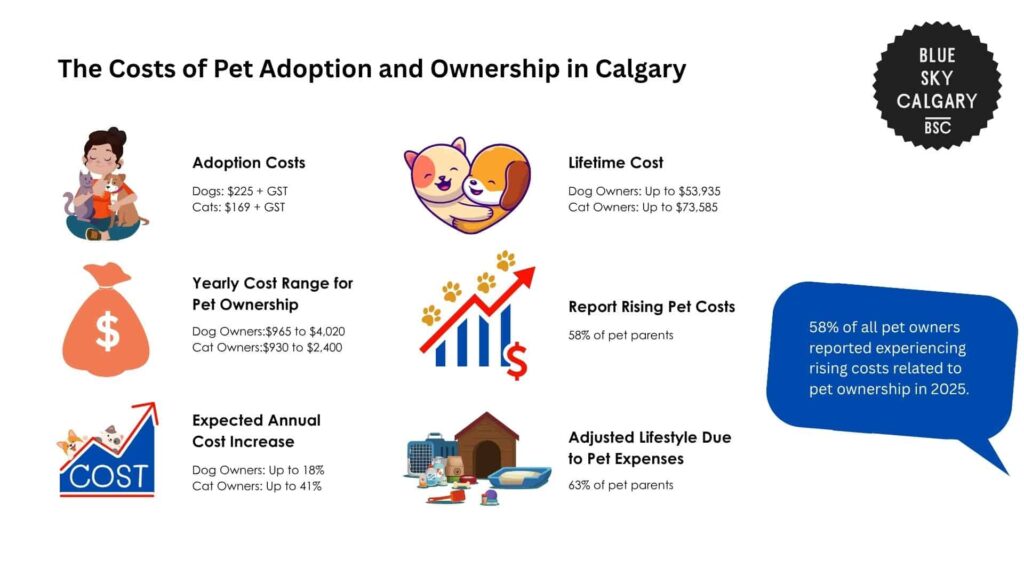
Pet Adoption and Welfare Services in Calgary
The City of Calgary and the Calgary Humane Society have introduced a range of interventions to support animal adoption throughout the city.
These efforts aim to improve adoption access, provide long-term support to pet owners, and address the broader issues of pet overpopulation and affordability.
Most significant here is that the City of Calgary reinstated its adoption program to respond to the growing number of homeless animals.
Appointments to adopt animals are now available through the City’s Animal Services Centre, where cats and dogs are placed for adoption by partner agencies, including the Calgary Humane Society and the Alberta Animal Rescue Crew Society.
This reintroduction provides structured pathways to adoption while managing intake levels across the city’s facilities.
Adoption fees have also been made more accessible. For those who cannot afford the standard adoption fees of $225 for dogs and $169 for cats, they also have a “hidden gems” group for animals who are a bit older.
Prices for these animals are much lower, at $84.52 for cats and $100 for dogs. These fees already cover essential veterinary and administrative services, including vaccinations, microchipping, City of Calgary licensing, and spay or neuter procedures.
The Calgary Humane Society complements these efforts with additional adoption benefits. All adoptions come with a complimentary wellness exam, six months of city licensing, and a one-year CHS membership.
New adopters also receive a six-week trial of pet insurance, a Royal Canin food sample pack, and species-specific educational materials. These resources ensure that animals transition into homes with proper care and support from the beginning.
In addition to basic adoption services, the Calgary Humane Society runs several programs aimed at making adoption easier and more affordable for hopeful adopters.
The Food Bank provides pet food and essential supplies to households experiencing financial hardship, reducing the likelihood of surrender caused by economic strain.
Older adults receive focused support through the Seniors Program. By offering help with daily care tasks, access to supplies, and guidance, the program allows seniors to maintain strong bonds with their pets.
Rosco’s Keep Them Home Fund assists families during emergencies by covering urgent veterinary expenses. The program plays a vital role in preventing the surrender of animals due to treatable health issues, especially among low-income households.
Veterinary access is further supported through the organization’s Wellness Clinics. These clinics provide affordable spay and neuter services, vaccinations, and other preventative treatments to reduce long-term health risks.
By improving access to care, minimizing financial barriers, and offering protection during emergencies, both the City of Calgary and the Calgary Humane Society hope to promote animal adoption in the city.
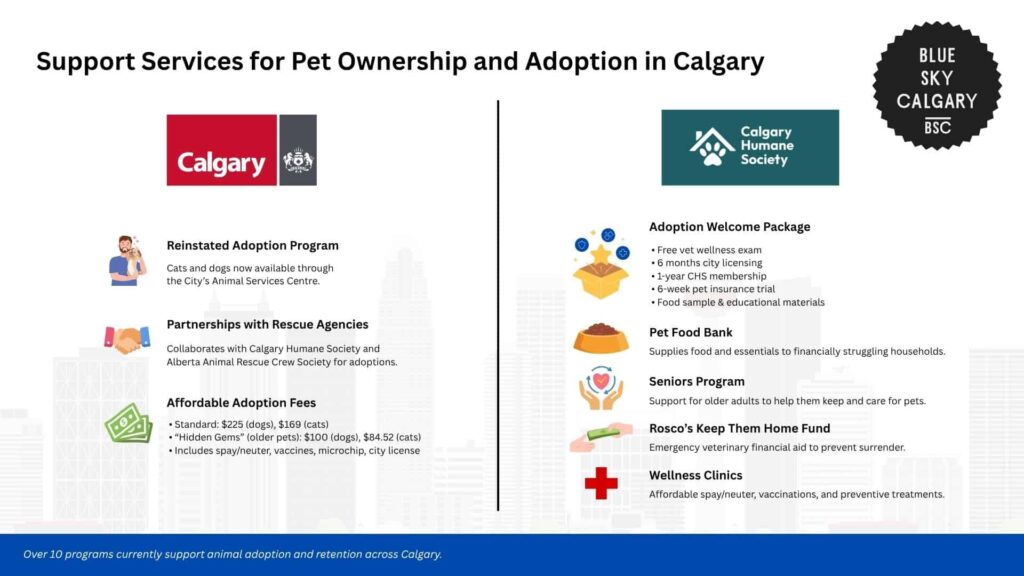
The Future of Animal Adoption and Service Trends in Calgary
Calgary is expected to see continued growth in demand for animal adoption and support services as a higher number of people seek to adopt more pets in the future.
To complement long-term adoption, shorter programs like foster care are likely to become the city’s primary model for animal housing. This is especially relevant given that Calgary already recorded 1,696 active foster homes in 2023.
Growth here will depend on the recruitment of more long-term foster families and the ability to match animals efficiently with homes.
However, the city’s actual adoption numbers may remain below previous rates. After a 53% drop in total placements between 2022 and 2023, future numbers may continue to decrease unless new campaigns or incentives are introduced.
Programs like discounted adoption fees, public awareness drives, and streamlined adoption processes may be critical in reversing this decline. Without these efforts, adoption rates may continue to drop, further straining shelter capacities.
Meanwhile, pet costs will also continue to shape adoption decisions. With yearly expenses already reaching up to $4,020, and lifetime costs going as high as $74,000, more families may postpone or avoid adopting pets altogether.
Thus, the city could also expect an increase in the demand for services that help reduce costs related to pet ownership. These include programs like pet food banks, free veterinary services, and affordable wellness clinics.
Over the next few years, both the City of Calgary and the Calgary Humane Society may need to increase investment in staff, outreach, and infrastructure to meet all of these rising demands related to pet adoption.
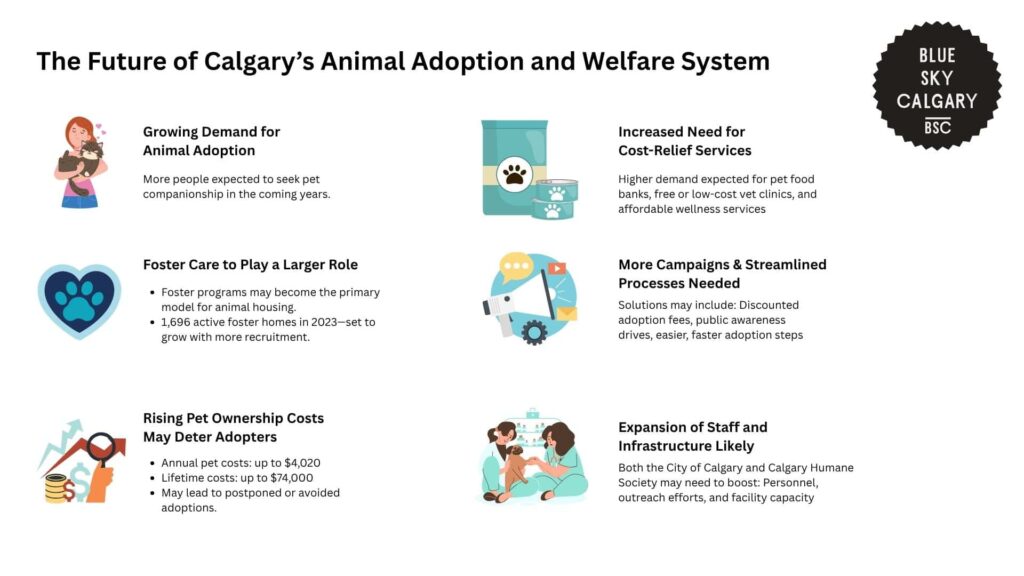
References
- Calgary Humane Society. (2024). 2023 Annual Report. https://issuu.com/calgary.humane.society/docs/annualgeneralreport-2024-digital
- Humane Canada. (2022). Animal shelter statistics 2021. https://aka-humane-canada-prod.s3.ca-central-1.amazonaws.com/attachments/clxui1vdo6s9611mqg2igdp4y-hc-animal-shelter-statistics-2021.pdf
- Government of Alberta. (2023). Pet owner and pet food trends (Issue 67). https://open.alberta.ca/dataset/3b09eacb-15ac-462e-80d0-fd0582d5eb15/resource/f75eb350-194c-481c-8cb2-8b198c475d08/download/agi-itrb-consumer-corner-pet-owner-and-pet-food-trends-issue67.pdf
- Village Life. (2025, January 19). The cost of pet parenthood in Canada: What to expect in 2025. https://www.village-life.ca/life/cost-of-pet-parenthood-in-canada-2025-10447832
- City of Calgary. (n.d.). Adopt a pet. https://www.calgary.ca/pets/adoption.html
- Calgary Humane Society. (n.d.). Community services. https://www.calgaryhumane.ca/community-services/
- Humane Canada. (n.d.). Home. https://humanecanada.ca/
- Charity Intelligence Canada. (n.d.). Calgary Humane Society. https://www.charityintelligence.ca/charity-details/212-calgary-humane-society#snapshot
- Calgary Humane Society. (2024). 2023 annual report. https://issuu.com/calgary.humane.society/docs/annualgeneralreport-2024-digital
- CochraneNow. (2024, January 1). Cochrane Humane Society saved 1,112 animals in 2024. https://cochranenow.com/articles/cochrane-humane-society-saved-1112-animals-in-2024
- Winnipeg Humane Society. (2025). 2024 impact report. https://winnipeghumanesociety.ca/wp-content/uploads/2025/01/ImpactReportWeb-1.pdf
- Edmonton Humane Society. (2024). 2024 annual report. https://www.edmontonhumanesociety.com/about/annual-reports/2024-annual-report/
- Etobicoke Humane Society. (2024). 2024 pet adoption numbers. https://etobicokehumanesociety.com/announcements/2024-pet-adoption-numbers/
- Regina Humane Society. (2024). 2023 annual report. https://reginahumanesociety.ca/app/uploads/2025/04/04232024-AnnualReport-FINAL.pdf
- Toronto Humane Society. (n.d.). Program impact reports. https://www.torontohumanesociety.com/purpose/program-impact-reports/
- Angus Reid Institute. (2023, July 17). Pandemic pets: One in five Canadians who adopted during COVID can’t afford them. https://angusreid.org/canada-pandemic-pets-veterinarians-insurance/
- City of Calgary. (n.d.). Pet adoption. https://www.calgary.ca/pets/adoption.html

